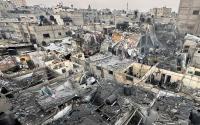29 December 2004Molly Bentley
Some slump as if sliding downhill. Windows and doors inch closer and closer to the ground.
It is an architectural landscape that is becoming more familiar as the world's ice-rich permafrost gives way to thaw.
Water replaces ice and the ground subsides, taking the structures on top along with it.
Alaska is not the only region in a slump. The permafrost melt is accelerating throughout the world's cold regions, scientists reported at the recent Fall Meeting of the American Geophysical Union (AGU) in San Francisco.
In addition to northern Alaska, the permafrost zone includes most other Arctic land, such as northern Canada and much of Siberia, as well as the higher reaches of mountainous regions such as the Alps and Tibet. All report permafrost thaw.
"It's a very, very widespread problem," said Frederick Nelson, a geographer at the University of Delaware, US.
Scientists attribute the thaw to climate warming. As the air temperature warms, so does the frozen ground beneath it.
Data quest
The observations reiterate the recent findings of the Arctic Climate Impact Assessment report, which attributed the northern polar region's summer sea-ice loss and permafrost thaw to dramatic warming over the past half-century.
Thawing permafrost can cause buildings and roads to droop, and pipelines to crack.
Natural features are also affected. Scientists reported an increased frequency in landslides in the soil-based permafrost of Canada, and an increased instability and slope failures in mountainous regions, such as the Alps, where ice is locked in bedrock.
With the exception of Russia and its long history of permafrost monitoring, global records are insufficient - often too brief or scattered - to determine the precise extent of ice loss, said Dr Nelson.
However, monitoring programmes that are now much larger in scope, such as the Global Terrestrial Network for Permafrost (GTNP), indicate a warming trend throughout the permafrost zone.
Boreholes in Svalbard, Norway, for example, indicate that ground temperatures rose 0.4C over the past decade, four times faster than they did in the previous century, according to Charles Harris, a geologist at the University of Cardiff, UK, and a coordinator of Permafrost and Climate in Europe (Pace), which is contributing data to the GTNP.
"What took a century to be achieved in the 20th Century will be achieved in 25 years in the 21st Century, if this trend continues," he said.
Slip and slide
In Ellesmere Island, Canada, a combination of warmer temperatures and sunny days has triggered an increasing frequency of detachment events, or landslides, over the past 25 years, compared with the previous 75, according to Antoni Lewkowicz, professor of geography at the University of Ottawa.
A detachment event occurs on a slope when the bottom of the active layer - the layer of thawing and freezing ground above permafrost - becomes slick with melted ice, causing it to slide off from the permafrost below.
But in this case, the amount of temperature increase is not so important as the rate of increase, Dr Lewkowicz found.
Meltwater from ice that warms slowly drains away. When ice warms quickly, water pools, creating a frictionless surface between the active layer and the permafrost. Like a stroll across a sloping icy sidewalk, a fall is almost certain.
"We have records from this particular site for about 10 or 12 years," said Dr Lewkowicz. "The years when active layer detachments have taken place have been times when we've had this rapid thaw down at the bottom of the active layer."
The slides may cut a wide swath hundreds of metres across, but extend only 50 or 60cm deep.
"They're almost skin-like landslides, moving across the permafrost," said Dr Harris.
The exposed permafrost, warmed by the air, now produces a new active layer.
Sink to source
In steep mountainous regions, permafrost thaw can lead to slope failure and rock falls.
In these areas, the permafrost ice is in hard rock. Where rocks are jointed, the ice serves as a kind of cement holding them together.
When it melts, the rock loses its strength and falls. A dramatic example of this occurred during the European heatwave of 2003 when a huge block of the Matterhorn broke off suddenly, leaving Alpine climbers stranded.
 Degraded permafrost will impact the migration routes of some Arctic species |
Dr Nelson says that with human-built structures, proper engineering and land use can mitigate permafrost loss.
Tingjun Zhang, a researcher at the US National Snow and Ice Data Center in Boulder, Colorado, reported at the AGU on the particular challenge slumping ground presents to the construction of the Qinghai-Xizang railroad across Tibet, perhaps the most ambitious permafrost-zone project since the Trans-Alaskan pipeline.
Nearly half the railroad will lie across permafrost, and temperatures in the region are expected to rise during this century.
Engineers are using a simple - and long established - trick of cooling the permafrost with crushed rock. Rocks minimise heat intake in summer and promote heat loss in winter.
It is the first time a large-scale project is using the crushed-rock method as its primary solution, according to Dr Zhang.
 Building codes will have to change if the thaw continues |
In the drier areas, most of the emissions would be in the form of carbon dioxide (CO2). But in the wetter areas, it would be methane, a more effective greenhouse gas.
Scientists do not know exactly how much carbon is sequestered in the permafrost regions, but estimates show it could be up to a quarter of the sequestered carbon on Earth, 14% of it in the Arctic, alone.
"Will the Arctic be a carbon sink, or convert to a carbon source?" posed Dr Nelson. "It's a big unknown."






